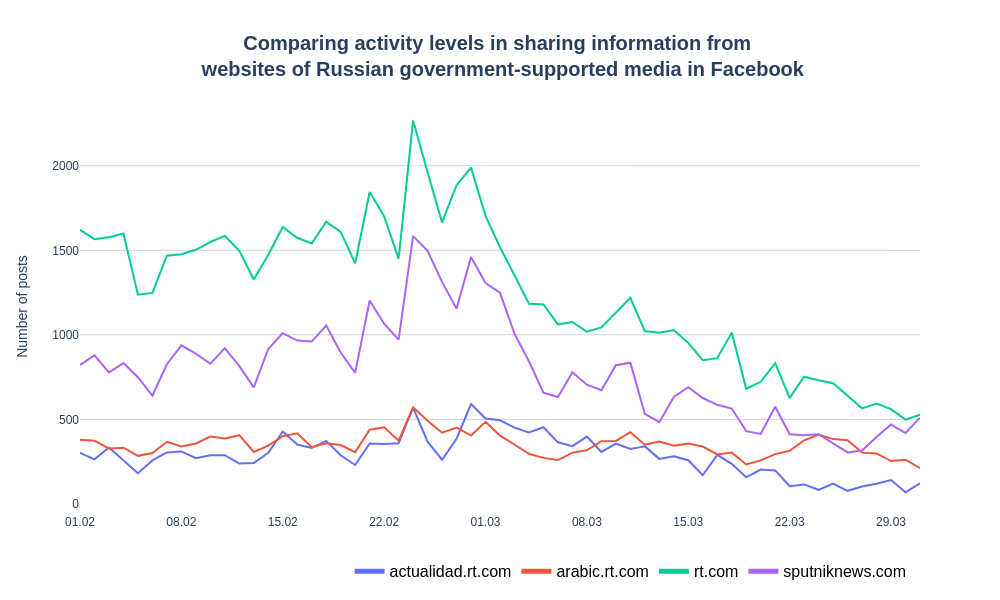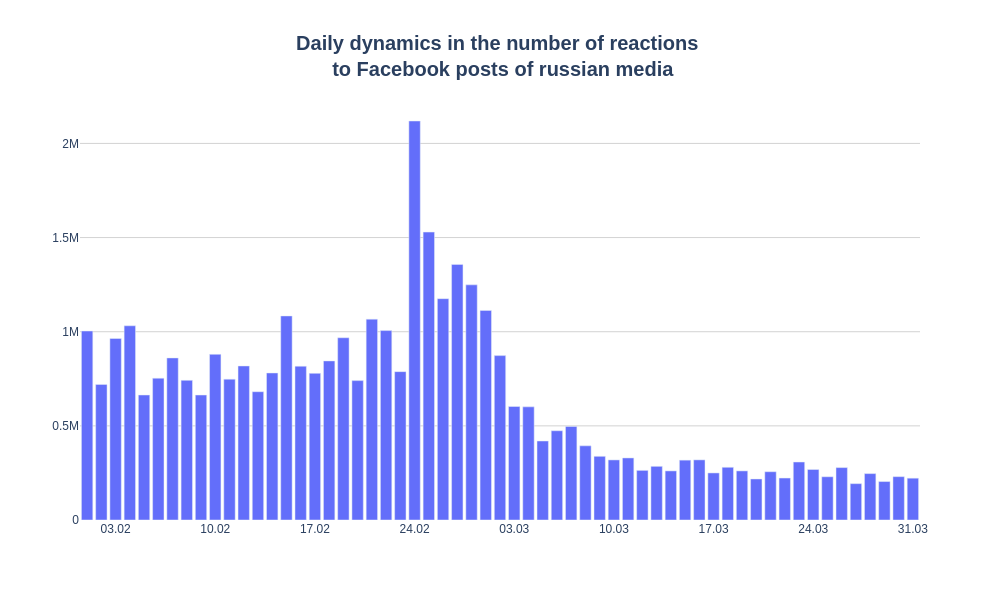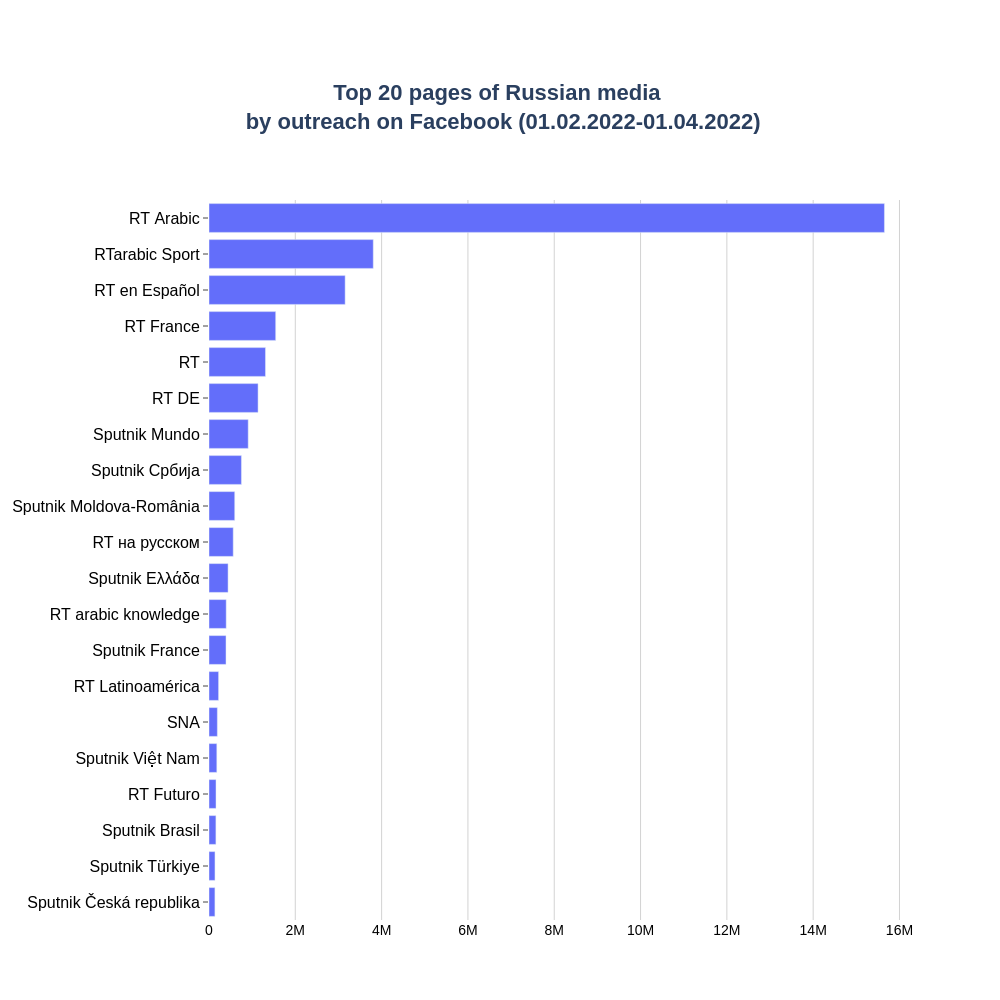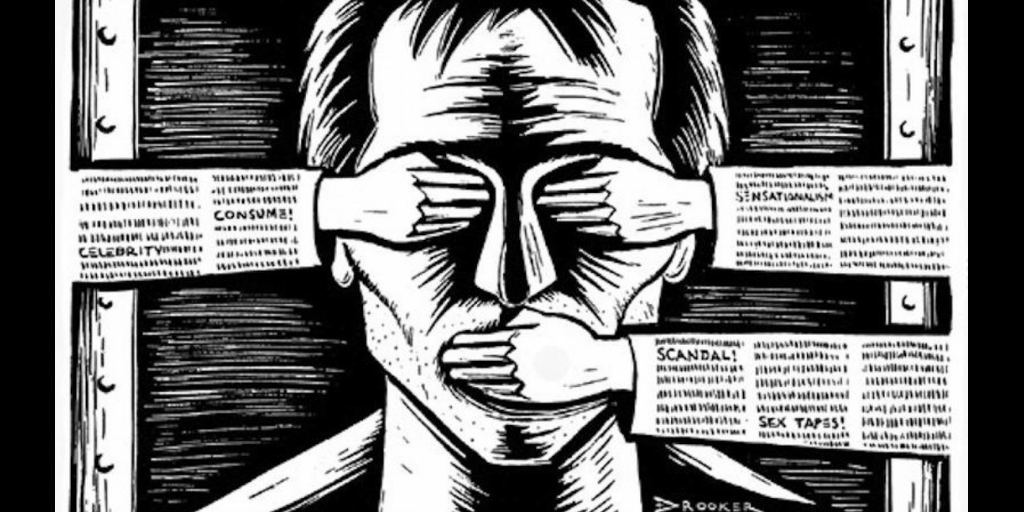The onset of the rf invasion into Ukraine’s territory coincided with the time when the aggressor state increased their expenses for the army and the law-enforcement. According to the russian ministry of finance, from January to March, 2022, russia has allocated the financial support for government media of 17.4 bln roubles (11.9 bln of them – in March), which is 3.2 times more than in the same period last year. In September, 2021, russian financial ministry suggested increasing the funding for government media in 2022 by 30%, as compared with 2021.
The “rising cost of services” of government media has not been random since today government-controlled media make the dominant source of information in the russian federation. In the context of the reinforced positions of government-supported media companies, independent media virtually suffer the destruction. Some of them have been blocked before the war in Ukraine, others were banned shortly after the onset of the purported “special operation.” In March, the roskomnadzor also blocked access to foreign social media for russians (Twitter, Instagram, Facebook).
However, a major challenge for Ukraine today is not about the attitudes within the russian federation or the fact that russian citizens are supportive of the war. Russia has long been exploiting all possible means to brainwash their own citizens and also the international audiences. It helps the aggressor state maintain the pro-russian attitudes in other countries. Moreover, in the critical moments, they can even show to their citizens the support from the West (such as the recent war supporting car rallies in Germany). Although it is somewhat harder to manage it in the countries of the West, amidst the array of alternative information sources, russia has been actively supporting their government-controlled media overseas. In this thread, we shall explore in detail how this is happening, and why the ban on Russia Today and Sputnik is an important but insufficient step.
Imposition of Sanctions
It has become obvious today that the information space is a full-fledge theater of war. Therefore, some countries of the West have taken to protecting their information space promptly after russia’s invasion. For example, as soon as on February, 25, Poland and Estonia committed to the cause. Shortly after, on March, 2, 2022, the European Council banned the broadcasts of television channels and the web content of Russia Today and Sputnik. However, support to Ukraine on the EU level does not yet ensure the information victory over russian propaganda in Europe. To begin with, the full-scale implementation of the decision is impossible without control of national regulators on the level of EU member states. Although RT and Sputnik broadcasts from open satellites have been blocked in Europe, local providers still enjoy the technical possibility to switch the RT channel and Sputnik radio. The map below shows the countries within the EU and beyond where the RT and Sputnik have been fully or partially blocked:
Secondly, content from websites of RT and Sputnik is accessible to Europeans via VPN and is shared through the social media. Thus, IT corporations started taking measures to restrict access to Russian propaganda from these two resources:
- On February, 28, Microsoft deleted RT and Sputnik apps from Windows App Store, and Meta restricted access to these pages on Facebook and Instagram for users in the EU. Please, find below the analysis about how the blockage for EU users affected the engagement of RT and Sputnik on Facebook.
- On March, 1, YouTube blocked the RT and Sputnik channels for the EU and UK.
- On March, 2, Apple deleted RT and Sputnik apps from global AppStore, and Google deleted them from the Play Store in the EU.
For Some Western Media People, Everything is Still “It’s Complicated”
Soon after announcements about blocking Russia Today and Sputnik in the EU, the International Press Institute (IPI) posted a statement where they raised their concerns about this step. The key line of criticism is about the following:
- any decisions to restrict activities of the media shall be made on the level of national regulators, rather than prescriptively,
- blocking russian media in the West may provoke the ban on Western media in russia; that is why russians have no access to reliable sources of information (although testimonies from Western media about Ukraine have no chance to pass the censorship under the russian law on fakes),
- a more efficient step to combat government-led disinformation, according to the IPI, will be to ban certain propaganda advocates sharing disinformation rather than to invest into the “professionalism and plurality of opinions in the mediascape, and the flourishing of independent journalism.”
Similar lines of argument have been actively used by the western media community to criticize the effort. We can find similar reflections with the authors in the The Conversation, The Washington Post, EU observer a.o. Specifically, Switzerland refused to block kremlin’s media on the national level, for the same reasons, while Danish government officials have concerns that the step may create a dangerous precedent restricting freedom of speech in journalism.
Indeed, the argumentation is important to keep transparency and independence of mass media at large. However, there are some important nuances why these do not refer to the russian government-led journalism.
First, we should go back to the history of creating Russia Today. Russian government founded international government-supported television channels “to improve russia’s image abroad.” Furthermore, according to putin’s words in 2013, it was supposed to be an “alternative” and the “russian voice in Anglo-Saxon information space.” How many more crimes against humanity does russia need to commit to eventually lose the voice in international community?
Secondly, any media, even the most responsible one, does not merely cover the objective reality. Any media are framing it, such as shaping an angle to perceive it and sets the agenda for their audiences. By selecting certain events/phenomena from thousands of daily events, and by choosing the manner of presenting them, the media build something that their audiences will find worthy of attention, and shape their attitudes. For the media directly accountable to the russian government, the only accessible perspective is to justify the “justice” of the Russian war on Ukraine. Direct subordination to the terrorist government which crimes have been officially condemned by EU member states disables any discussion about RT and Sputnik, the same as about any other media.
The absolute priority for the freedom of speech may lead to losing it. Plurality of opinions cherished by Western democracies may be possible with equal dialogue between all participants of the social debate. A German philosopher, Karl Popper, formulated the tolerance paradox back in 1945 – societies that tolerate discrimination may not be considered tolerant any longer. Intolerant groups will abuse the possibility to share their narratives to discriminate others. Kremlin agenda shared by Russia Today and Sputnik fuels a myth about Ukrainians as the “Nazis” and justifies the so-called “special operation,” a myth that has recently enjoyed support during pro-Russian protests in several cities in Germany.
Government Media vs Europe’s Sanctions: Is the Blocking Efficient?
We have explored into a theoretical part of the problem: since russian propaganda affects people’s opinions to developments in Ukraine, it must be blocked. However, is it effective enough?
We analyzed how engagement of russian media has changed on Facebook upon blocking the Russia Today and Sputnik in some countries. To that end, we collected 50 websites of government-led rf media (including RT, Sputnik, websites of the “russia today” mediagroup, “ANNA News”, “VGTRK”, “Gazprom-Media”, “National Media Group”, interfax, Lenta.ru, TASS and some regional websites of these media). With the help of Crowdtangle (Meta tool for social media analysis), we aggregated posts from February, 1, to March, 31 that shared links to the selected 50 websites.
In total, from February, 1, to March, 31, 236,413 links to websites of russian government-supported media were posted on Facebook. However, it shall be noted that Crowdtangle does not collect posts from personal non-verified pages or from groups and pages with few followers. Therefore, the actual outreach of government-supported russian media is much larger than the quoted data. Nevertheless, their number was equally distributed: in February, there were almost 154,000 such links, while in March, the number halved (82,000). The chart below shows the dynamics of daily numbers of posts of the two blocked websites of Russia Today and Sputnik, compared with the activity levels of other government-supported media (a more detailed charts for each website can be viewed here).
The posts most actively shared by users included links to rt.com (17,617 posts), sputniknews.com (46,469 posts), arabic.rt.com (20,848 posts), actualidad.rt.com (16,942 posts), ria.ru (14,203 posts). It is notable that after March, 2, (the date of blocking Russia Today and Sputnik in the EU), the number of posts from the blocked sources has plummeted but the posts from other rf government-controlled resources have been dropping at a lower rate.

Similar dynamics can be supported by several other indicators: if you take a look at the number of likes, shares, and comments under the posts published over the two months, you can see that they drop gradually.

Where and How Russian Government-Prompted Propaganda is Shared on Facebook?
Over these two months, russian propaganda was most actively shared from Facebook pages (61.8% of posts) and Facebook groups (38.1%). Public figures (verified accounts) posted information from russian government media 193 times only (0.1%). Thereat, it is notable to see that Facebook pages themselves generate most of views for the government propaganda, as well as most user-content engagement. Thus, 98% of all reactions have been left by users on such pages, and less than 2% were marked in Facebook groups. The total number of such pages was 19,126 but as few as 2,007 pages shared posts of russian media on a regular basis — over 10 times in 2 months.
Among the Facebook pages, over 50% of engagements with posts (likes, comments, reposts) are accounted to a group of Arabic pages of Russia Today (RT Arabic, RTarabic Sport, RT arabic knowledge, etc.). Thus, the two pages alone, RT Arabic and RTarabic Sport, reached almost 20 mln users on Facebook in February and March, publishing over 30,000 posts. Despite the restrictions, rather high outreach has been achieved by propagandists from Spanish, French, British, and German pages of Russia Today.
All 20 pages with the highest outreach are directly administered from russia, and currently they are not accessible to users from Ukraine and the EU. At the same time, it means that their total deletion and blocking from Facebook paralyses and largely reduces the efficiency of russian international Internet propaganda.

We explored key features of the pages sharing information from russian government-led media and analyzed the geography of their administrators. It can be seen that most page administrators sharing russian government-supported propaganda do not come from the russian federation. Certainly, russians also administer the pages but they are only 163. On the other hand, 166 administrators stay in France, 164 — in Mexico, 89 — in Armenia, 101 — in the USA. Many administrators also stay in South America (at least 474) and in the EU (370).
Moreover, we analyzed the language of posts sharing the links of russian government media. Arabic is the most popular language (33,860 posts), followed by russian (26,805 posts), and Spanish (21,531 posts). French (12,484 posts) and English (7,709) go as third and fourth most widespread languages. Languages of some of the former Soviet have been spotted, too (Armenian, Lithuanian, Tajik, a.o.) and other EU countries (Romanian, German, Polish, Italian, etc.).

Upon the whole, because of restrictions, activity levels of russia’s government media on Facebook have been decreasing. However, it is important to understand that despite the dropping engagement on some pages, we can still see that Facebook is a place where russian propaganda actively shares their messages. In particular, on March, 31, on Facebook, we identified at least 2,040 posts from propagandist resources. The numbers are certainly four times smaller than the maximum of 8,027 on February, 24, but it is still much enough to continue shaping public opinions internationally, Russian propaganda keeps using all available tools to share their narratives all over the world. For example, the Russian propaganda denying mass killings of Ukrainians in Butcha committed by russian military men.
Conclusions
Restricting the broadcasts of television channels and online content by government Russian media, russia today, and sputnik, had a positive effect. Upon blocking, the engagement of the websites suffered a major decline, the same as engagement of users with their content on social media. However, we must stay on our toes not to think that the victory is ours. The fight continues as the amount of content and engagement with it still is above zero: e.g., on March, 31, Russian government media had over 2,000 shares and over 218,000 likes.
Moreover, we only managed to gain a partial victory over russian propaganda in Europe and several other countries in the world. At the same time, the propaganda content in Arabic has been still actively shared on Facebook and other social media platforms, while the propagandists intend to embrace the media market of African countries.
